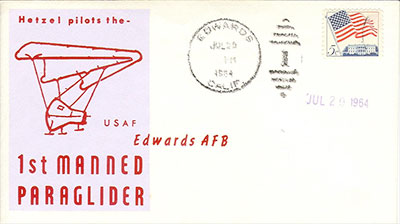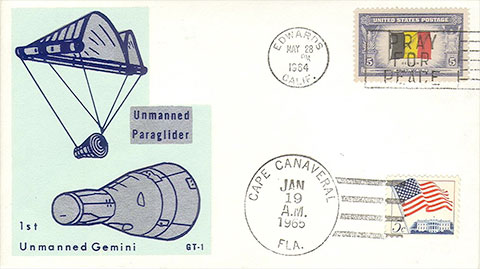Space Cover #25, Gemini's ParagliderWith the recent death of Francis Rogallo, let's take a look at his work that was tested for flight (but not implemented) on Gemini - the Paraglider.
In an effort to keep from having to rely on multiple Navy ships scattered around the globe to recover the Gemini capsules, a land-landing system based upon Francis Rogallo's paraglider (a triangular-shaped combination of a parachute and a wing) was tested. The paraglider was to allow Gemini to glide horizontally to a landing on a dry lake bed on a set of landing skids. Tests began in 1962 with a half-scale model of Gemini, and in 1964 with a full scale model at Edwards AFB. Most of these tests ended unsuccessfully.
The first successful test at full scale (unmanned) happened on May 28, 1964 at Edwards AFB. The Velvetone Cachet cover at top was postmarked at Edwards, Ca that day and shows a cartoon of the paraglider in the upper left. The cover was later double-postmarked at the Cape for the unmanned Gemini 2 test flight.

On July 20, 1964 pilot E. P. Hetzel completed the first manned flight of the paraglider as shown on the lower Velvetone Cachet, hand cancelled at Edwards that day. The paraglider flights commemorated on these two covers were rarities in that both were successful.
On August 7, 1964, Hetzel had to bail out of the Gemini Paraglider test vehicle and it crashed. NASA decided to cease funding the paraglider for Gemini three days later. However, the test vehicle was rebuilt as a research tool, and on December 19, 1964, pilot Don McCusker was able to successfully-but-roughly land the test article, sustaining minor injuries, and ending the project.
The Velvetone Cachets are a story in themselves. Bob Rank (later of Space Voyager Cachet fame) had to print the cachet line art onto each cover and then sprinkle each cachet with different powders to produce the different colors and textures. The covers were then baked in his kitchen oven with the result being cachet art that had a velvet-like feel to it. As you may imagine, this was a labor-intensive process for Rank and he produced only a few tens of Velvetone Cachets for each event that he commemorated. And he commemorated over 200 space events on Velvetone Cachets through the 1960's before turning to printed Space Voyager Cachets.
For more information on the Gemini Paraglider, I would recommend Ed Hengeveld's excellent "Paraglider: Land Landing for Gemini".













